
Starter Fertilizer — When is it Needed?
As planting season begins, farmers often question if starter fertilizer is providing yield and economic benefits. Starter fertilizer is defined as fertilizer applied with the specific purpose of helping the plants acquire more nutrients early in the season. This is in addition to the fertilizer used in the nutrient management program that is based on deficiency correction/sufficiency approaches.
There are two main reasons to use a starter:
- The best reason is when soil tests indicate the field is deficient in one or more nutrients, and these nutrients are relatively easy to apply with the planter.
- The field to be planted is covered with more than 70% residue and you expect the soil to be cool and wet.
Additionally, back when most growers cultivated, starter made the young corn plants taller and greener quicker, which allowed cultivation to occur earlier in the season, and resulted in better weed control. Also, phosphorus applied with the planter helps the plants mature earlier which can also result in drier corn.
If starter is going to be placed near the seed, be sure the dose will not hurt germination and stand establishment. (See the NebGuide, Using Starter Fertilizers for Corn, Grain Sorghum, and Soybeans.)
If the soil test levels for the starter nutrients are greater than the critical value for these nutrients, starter will probably not help yields, especially on fine-textured soils (Wortmann et al., 2005). Spending time loading the starter material and making sure all the equipment is working may take valuable time during planting.
Grower Research with Starter Fertilizer in Corn

From 1995 to 2019, farmers working with the Nebraska On-Farm Research Network conducted 35 studies looking at starter fertilizer on corn. The results of these studies can be found in the Results Finder database. Some were in the same field for a number of years, others moved around. Various starter materials were evaluated, and not all studies reported soil test P levels.
Eighteen of the studies compared a 10-34-0 starter fertilizer in the range of 4-6 gal/ac to a no starter check (Figure 1). Soil P levels were between 4 and 35 ppm; not all studies reported the specific P extractants used. Here we report crop yield response across range of soil P levels:
- For soils with P soil tests at or below 10 ppm there was an average yield increase of 14.3 bu/ac due to the starter (four sites).
- For soils with P soil tests of 10-20 ppm there was an average increase of 2.6 bu/ac (five sites).
- For soils with P soil tests of 20-35 ppm, there was an average increase of 0.3 bu/ac (nine sites).
- When all the data were combined, regardless of soil test values, there was an average increase of 4 bu/ac.
This analysis disregards statistical analysis. Of the 18 studies, only five had statistically significant differences. Of these five, the average yield increase was 12 bu/acre and the average soil test P level was 9 ppm.
Grower Research with Starter Fertilizer in Soybean
A similar analysis of the soybean on-farm research found six starter studies between 1992 and 2015, with only three sites reporting soil test P, all of which were greater than 17 ppm. Average yields for the no-starter studies were 61.2 bu/ac and for soybeans with starter, 61.3 bu/ac.
Review and Conclusions
Using corn as an example: Results are mostly consistent with our recommendations. (See Nutrient Management Suggestions for Corn.) The University recommends phosphorus based on the following formula for corn following corn or crops other than soybean:
Pounds of P2O5/ac = (25 - Bray-1 P) x 4
For soils in the 15 to 20 ppm Bray 1P range, the recommendation would be for 20 to 40 pounds of P2O5. Applying five gallons of 10-34-0 would provide about 20 pounds of P2O5 and would be economic most of the time. For other recommendation options, see NebGuide: Nutrient Management Suggestions for Corn.
To summarize, when fertilizer is used as a starter (as defined above with soil test levels above the critical value), the data shows that it is largely not effective in terms of yield or economical response; however, if the fertilizer is added to a soil that tests low for soil test P (less than the critical value), a response to that fertilizer is expected.
Test it Yourself
Curious if starter fertilizer is paying for itself on your farm? Consider conducting an on-farm research trial. The Nebraska On-Farm Research Network provides a simple protocol to allow you to evaluate the yield and economics of adding starter fertilizer to corn or soybeans. To get started, contact a member of the Nebraska On-Farm Research Network team or your local cropping systems extension educator.
Cited Publications
Wortmann, C.S., S. Xerinda, M. Mamo, C.A. Shapiro. 2005. No-till row crop response to starter fertilizer in eastern Nebraska: i. Irrigated and rainfed corn. Agron. J. 98:156-162.
Note: This article is a revised version of a April 12, 2017 publication.
Online Master of Science in Agronomy
With a focus on industry applications and research, the online program is designed with maximum flexibility for today's working professionals.
